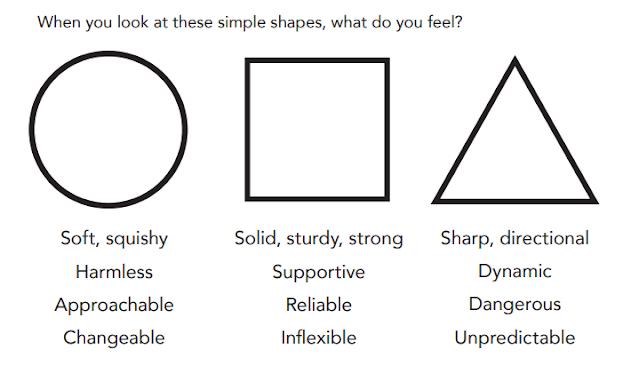We are now onto our major project, and final module. The year is coming to an end, and my aim is now to create work to add to my portfolio that I'm proud of.
Currently, I know my plan is to focus on character design, and potentially to back up my work with discussions on story-telling/narrative in character design, as well as bias in character design.
There are some basic elements in character design that are meant to tell an audience a lot about a character without saying it outright, a common one is "shape language":
 |
| Fig. 1: WaltDisney.Org, 2020. Shape Language |
Shape language is often strongly utilised in animation, where shapes and character designs are exaggerated for readability. Combining these shapes can also create different ideas of how a character is or behaves. A character like Mr. Incredible from The Incredibles (2004) is mostly square in shape, to show his strength, but also has rounded features to suggest friendliness. This post by Keenan Acebedo shows how a combination of shapes can be used to create a diverse line-up of characters.
In animations aimed at an older audience, shape language is often still used but in a subtler way. For example, Vi (fig. 2) in Arcane (2022) has squared shoulders and a rounded face, but also sharp shapes in her hair - her design suggests she is a protagonist, but not necessarily friendly.
 |
| Fig. 2: Theuillon, 2022. ARCANE - Vi |
At the same time, designs can be used to show aspects of a character that may change in the narrative of the media they're in. To use Arcane as an example again, the character Caitlyn (fig. 3) is training to become an enforcer; her uniform is clean, symmetrical, and orderly, suggesting she is someone who would want to maintain structure and law. In the show, Caitlyn becomes rebellious, as she's put in a position of choosing between her personal feelings of what's right, and what she's been raised to believe in and stand for.
 |
| Fig. 3: Theuillon, 2022. ARCANE - Caitlyn |
In designs for games with realistic art styles, or live-action films, much of the narrative in design is put into the clothing. Vi's outfit in fig. 2 is mostly asymmetrical, except for her shirt, which has the sleeves ripped off, suggesting it's secondhand or stolen. Vi's design against Caitlyn indicate differences in the characters' upbringings and social standing.
 |
| Fig. 4: Reeves, 2016. Corvo Attano, Dishonored 2 (2016) |
In Dishonored 2 (2016), the design for Corvo Attano features asymmetry, but also reflects rank and class. This is also reflected in the design for Emily Kaldwin (fig. 5), Corvo's daughter and Empress of the Isles. Their clothing is clearly tailored but built with purpose. Gold accents and use of deep blues and purple highlight their social ranking, but features like belts for carrying weapons show they're capable of fighting.
 |
| Fig. 5: Bishop, 2016. Emily Kaldwin, Dishonored 2 (2016) |
Asymmetry also draws focus and interest towards a character, as usually generic background characters and NPCs have plainer designs that can be repeated, and clearly indicate who the character is without distraction. This is often seen in guard and citizen NPCs whom the player doesn't need to interact with (fig. 6). A character who is part of the guard, but is also part of the story, may have changes to the standard uniform to make them stand out and show more importance, such as removal of a helmet or mask, or a change in uniform colour, e.g. High Overseer Campbell in Dishonored (2012) wears a red uniform to indicate his higher rank, and no helmet (fig. 7).
 |
| Fig. 6: Buliarca, 2012. Overseer, Dishonored (2012) |
 |
| Fig. 7: Dishonored Fandom Wiki. High Overseer Campbell |
In this post by Magdalina Dianova on "How to design a compelling character that tells a story", she goes into how to show the kind of person a character is through their design:
"The very first step in my process is to come up with an idea about my character’s personality and think about who they are. All I need is a keyword - something to begin with. The first one that pops in my mind is ‘antisocial’. From there I start asking basic questions - Why is my character antisocial, how does that affect their life, how do they perceive the world?"
She then builds an inspiration moodboard, using images of real people and film characters that match the personality of the character she wants to create. This is followed by exploration sketches and a final rough drawing of the design. Using this method, as I have done, as well as some world building to compliment my work, I plan to begin designing a character next week.
I've been writing notes of ideas, and narrowing down what I'd like to work on. I'm looking at games I like, such as Dishonored (2012), BioShock (2007), and Bloodborne (2014), to draw inspiration and art style.
References:
DIANOVA, Magdalina. 2019. 'How to design a compelling character that tells a story' [online] 3DTotal. Available at: https://3dtotal.com/tutorials/t/how-to-design-a-compelling-character-that-tells-a-story#article-introduction [Accessed on: 06/06/2023]
Images:
Figure 1. WaltDisney.org. 2020. Tips & Techniques: Shape Language. waltdisney.org/education-resources [online]. Available at: https://www.waltdisney.org/sites/default/files/2020-04/T%26T_ShapeLang_v9.pdf [Accessed on: 02/06/2023]
Figure 2. THEUILLON, Candice. 2022. ARCANE - Vi. ArtStation [online]. Available at: https://www.artstation.com/artwork/b505vm [Accessed on: 02/06/2023]
Figure 3. THEUILLON, Candice. 2022. ARCANE - Caitlyn. ArtStation [online]. Available at: https://candicetheuillon.artstation.com/projects/aGy4zz [Accessed on: 02/06/2023]
Figure 4. REEVES, Ben. 2016. Corvo Attano, Dishonored 2 (2016). Gameinformer [online]. Available at: https://www.gameinformer.com/b/features/archive/2016/05/11/get-reacquainted-with-corvo-attano-from-dishonored-2.aspx [Accessed on: 05/06/2023]
Figure 5. BISHOP, Sam. 2016. Emily Kaldwin, Dishonored 2 (2016). GameReactor [online]. Available at: https://www.gamereactor.eu/take-a-look-at-the-fashion-of-dishonored-2/ [Accessed on: 05/06/2023]
Figure 6. BULIARCA, Christian-Marius. 2012. Overseer, Dishonored (2012). ArtStation [online]. Available at: https://www.artstation.com/artwork/QVVll [Accessed on: 06/06/2023]
Figure 7. Dishonored Fandom Wiki. High Overseer Campbell. Dishonored Fandom Wiki [online]. Available at: https://dishonored.fandom.com/wiki/Campbell%27s_Lamentation [Accessed on: 06/06/2023]



No comments:
Post a Comment